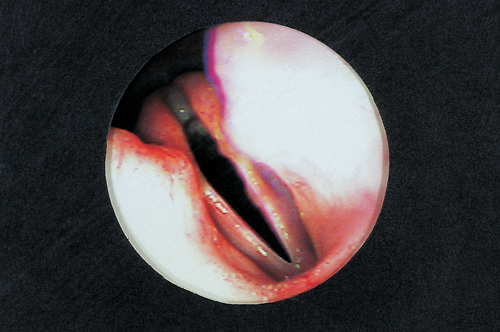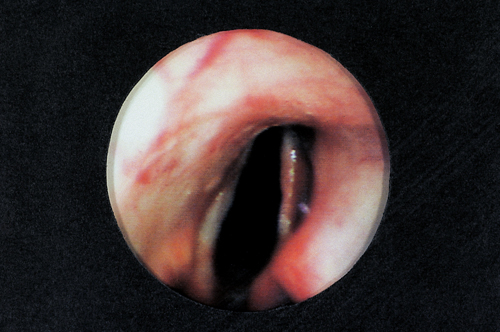Small Animal Soft Tissue Surgery Q&A 22
| This question was provided by Manson Publishing as part of the OVAL Project. See more Small Animal Soft Tissue Surgery Q&A. |
The top photo is an intraoral endoscopic picture of an eight-year-old, spayed female Labrador Retriever that presented to the emergency clinic for dyspnea. The owners reported an acute onset of respiratory distress; upon further questioning, you learn that the dog has also had a change in her bark and she seemed to have respiratory difficulties last summer as well.
| Question | Answer | Article | |
| Based on the history and illustration, what is your preliminary diagnosis? | Laryngeal paralysis. Idiopathic laryngeal paralysis is usually seen in large-breed dogs (Retrievers, Saint Bernard, and Siberian Husky) over nine years of age. Other etiologies include trauma, hypothyroidism and congenital paralysis. Clinical signs include voice change; gagging or coughing while eating; inspiratory stridor; and dyspnea, cyanosis or even syncope. |
Link to Article | |
| How will you confirm the diagnosis? | Diagnosis is by laryngoscopic observation of the arytenoids under sedation light enough that the gag reflex remains present. Failure of the arytenoid cartilages to abduct during inspiration or cough is diagnostic. Cervical and thoracic radiographs are made to rule out other possible respiratory diseases. |
Link to Article | |
| Name three surgical procedures that can be used to correct this problem and what complications might be encountered with each? The bottom photo is a postoperative intraoral endoscopic view of this animal. | Three surgical procedures are:
|
Link to Article | |

